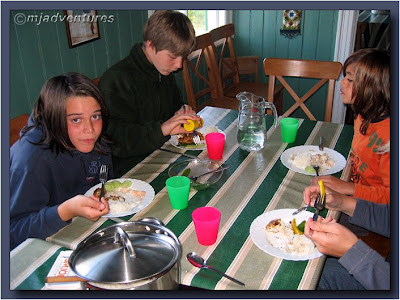We quickly befriended the other long-term lodge residents - a mother and son from Lake Constanz on the German/Swiss/Austrian border. C and F had been coming to Hesteyri for many years and knew Birna's family and the area very well. We couldn't have asked for better companions during our stay. We immediately hit it off with C who is a theater Production Manager, so she and I kept ourselves entertained by singing songs from musicals. Her son F was 2 years older than our oldest, but F spoke German (as well as English) so that was ok as far as our boys were concerned! Over the course of the next few days, we would go on many adventures with C and F around the fjörd, but today we were going fishing!
Hrólfur had a small red Zodiac inflatable on which he was taking us out. C chose to stay onshore, so F accompanied J, myself, our 2 boys and Hrólfur. It was a juggle to get all of us on the Zodiac but we were determined to manage. Life jackets were compulsory because if any of us went over the side into the cold water, we were going to struggle to keep alive. Hrólfur sobered us all up by saying that our life expectancy in the freezing water could be no more than 15 minutes if we were lucky.
I should note that during our stay, Hesteyri was experiencing unusually settled weather with little wind and clear skies. This was not the norm as Iceland's weather was more like Melbourne's and New Zealand's, and it can often be Four Seasons in One Day. In neighbouring fjörds however, it had rained constantly. At the same time as we were fishing, J's friend and her sons were completing a 3 day hike a couple of fjörds away, and they had rain the entire time.
On a calm Hesteyrarfjörður, we sped off from the jetty with the cold air forcing its way into every gap in our clothing, chilling our skin and making our eyes tear up.
Click on the images to enlarge
It was a relief when the boat stopped and Hrólfur readied the 2 rods. We were jigging with plastic lures that looked like worms. Apparently Icelandic Cod love them.
The first strike went to me, but the fish was too small to keep, so back over the side it went. The next one was better, and soon we had keepers to take home. We took turns at the rods, changing over as we each caught a fish.
We started joking about having our own Cod War, except that it was humans against the fish instead of Icelanders vs. English fisherman as it had been in previous Cod Wars!
The boys were into the fishing and us girls were having a hard time getting turns on the rods. In the excitement, they seemed to forget that there were others who wanted a go! We fished at 3 different locations and after about 90 mins, when we had enough fish onboard for dinner, we returned to Hesteyri.
A and M were keen to pose with their fish. It's true - most boys are happy fishing and it showed in their faces - particularly in the older one's case.
The bucket of fish went into the stream to chill until the evening when Hrólfur would fillet them. He had already gutted the fish as we had brought them onboard. It saved having to deal with the smelly innards once we were back on land, and the seagulls loved them!

The boys gathered around to watch Hrólfur at work. I've gutted and filleted many fish in my time, but sometimes it just pays to keep quiet about those skills and let someone else do the dirty work!
By the way, if you ever come to this part of the world, call into your outdoor shop and buy a headnet like the one that F has on in the below image. The tiny midges and flies are a constant nuisance, and buzz around the moist areas (eyes, mouths and noses) of people's faces. They are very annoying!
Soon we had some beautiful fresh cod fillets waiting to be cooked.
While Birna egged and floured the fillets, I was cooking them on a medium heat until the outsides turned golden brown. The fish was falling apart, it was so tender. J and C cooked rice and prepared a salad, and then we sat down with Birna to enjoy the food. It was delicious. We were all so full, but couldn't resist eating more than we should have. We had a few pieces of cod left over which we shared with some other campers who were very appreciative - after having been on 3 day hikes with no fresh food in that time!
Next Chapter: The Hesteyrarfjörður flora


















































